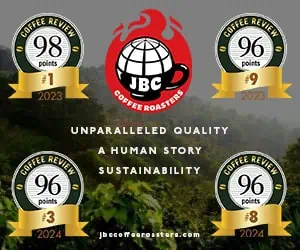India is a considerably better-known coffee origin in Europe than in the United States. And even in Europe it tends to be a source whose profound coffee originality is hidden inside blends rather than foregrounded in single-origin or trophy coffees. For example, India provides some of the world’s most valuable coffee types for espresso blends, yet these same exotic coffee types are seldom offered as single origins. They are simply too intensely odd for American palates accustomed to the high-grown, cleanly bright profiles of classic Latin America. On the other hand, the majestic, deeply forested old India coffee estates do produce quietly distinctive Arabicas capable of pleasing even the most purist of coffee drinkers. And the quest for small lots of coffee that play distinctive variations on the more familiar Arabica profile is beginning to turn up some pleasant surprises in India, as it has elsewhere in the world.
All of these types and trends are represented in this month’s reviews, representing a set of ten often wildly different coffees, the best and most interesting from the thirty or so we cupped. Here they are in summary:
1) For coffee adventurers with a taste for low-acid, heavy-bodied, sweetly nutty profiles: The Paradise Roasters Indian CxR Mandarin (89), a coffee from trees of an interspecies cross between an heirloom Indian variety of Robusta and the coffee species Congensis.
2) For coffee adventurers with a taste for low-acid, richly malty profiles with a little twist of fermented fruit: Three different Monsooned Malabars, the unique Indian coffee type created by allowing dry-processed coffees to absorb the salt- and moisture-laden air of monsoon winds in an effort to mimic the flavor of coffees once carried in the holds of wooden ships from India to Europe. The Julian Coffee Roasters Monsooned Malabar (89), the Josuma Coffee Monsoon Medley (88) and the Storehouse India Malabar (87) all represent variations on the musty/malty, sweetly pungent monsooned theme.
3) For I’ll-try-anything coffee adventurers, a coffee from trees of the Liberica species. Liberica was first experimented with as a disease-resistant alternative to Arabica, but was pretty much abandoned after the development of Robusta. It is still grown on some farms in India, however, as well as in Malaysia, where it is often a valued component in the pungent, heavily intense blends that Malaysians enjoy buffered by quantities of milk. The Badbeard’s India Anokhi Liberica is reviewed here at 87, a basically arbitrary score. There are no criteria I know of by which this coffee could be rated 90, for example, or even 88. On the other hand, we have no business completely trashing a unique coffee type on the basis of standards of judgment developed mainly for fine Arabicas. As Libericas go, this seems like a rather attractive one. Therefore, well, with a mix of confusion and generosity, plus respect for originality, we settled on 87. But pick your own number: 0, 50, 80, 90? If you try it, do it the Malaysian way, brewed strong and taken with a lot of hot milk or warm half-and-half.
4) For the purist, three estate-grown, traditionally wet-processed Arabicas, the top-rated Tony’s Coffee & Tea Balmaadi Estate (91), the Zingerman’s Elk Hill estate (88) and the rather unusual salty-sweet, floral-toned Badbeard’s Kattehollay Estate Peaberry (88).
5) Finally, for those interested in small-lot trophy coffees that reflect experiments with botanical variety and processing method, we have the Kaapi Royale Selection 9 Pulped Natural (91), a coffee from trees of a variety (Selection 9) with Ethiopian heritage, processed by the unorthodox pulped natural method, in which the skins are removed but the sweet fruit pulp is allowed to remain on the beans as they dry. The result here is a subtle, delicate balance of aromatic wood, flowers and dark chocolate notes. The “natural” or dried-in-the-fruit Arabica from Sethuraman Estate (90) is a restrained and elegant version of the fruity style of natural dry-processed coffee.
Nothing this month soared in the ratings, yet the range of coffee expression in the cupping was impressive, even startling in its variety. As relationships between American roasters and Indian producers mature, I expect we will not only continue to experience a continued variety of coffee expression from India, but more refined and precise versions of that expression as well.
2009 The Coffee Review. All rights reserved.












